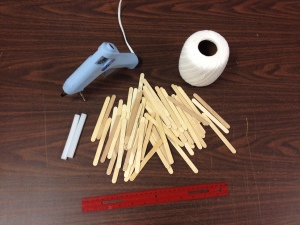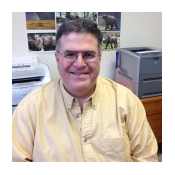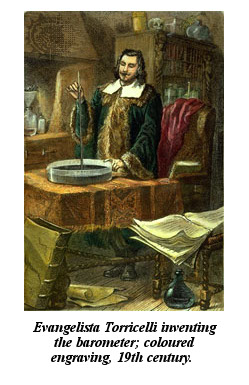February 9, 2015
 by: Evan Jones
by: Evan Jones
How the SpillNot works:
When you hold a cup of juice while walking, the juice tends to spill because the cup accelerates forward (ax, FIG.1, green arrow) and backward (-ax) with each step. The juice tips in response to that acceleration, and may spill over the rim of the cup.
 The Spill Not automatically tips the cup so that its top stays parallel to the juice surface (FIG.2). For example, if the juice surface tips to 30 deg, but the cup stays horizontal, the juice could spill. But if the cup also tips to 30 deg, we get no spill! Note that there are only 2 forces on each portion m of juice…the weight mg down, and the buoyancy force Fb of the juice pushing at a right angle to the surface. These two forces result in a horizontal accelerating force ma (in red). We see from FIG.1 that
The Spill Not automatically tips the cup so that its top stays parallel to the juice surface (FIG.2). For example, if the juice surface tips to 30 deg, but the cup stays horizontal, the juice could spill. But if the cup also tips to 30 deg, we get no spill! Note that there are only 2 forces on each portion m of juice…the weight mg down, and the buoyancy force Fb of the juice pushing at a right angle to the surface. These two forces result in a horizontal accelerating force ma (in red). We see from FIG.1 that
Read the rest of this entry »
 2 Comments |
2 Comments |  College level, experiments, High School level, Physics | Tagged: acceleration, centripetal force, hands-on activity, homeschool, parent friendly, PBL, pendulum, phenomenon based learning, phenomenon-based science, Physics, science, Spill not |
College level, experiments, High School level, Physics | Tagged: acceleration, centripetal force, hands-on activity, homeschool, parent friendly, PBL, pendulum, phenomenon based learning, phenomenon-based science, Physics, science, Spill not |  Permalink
Permalink
 Posted by Tami O'Connor
Posted by Tami O'Connor
January 29, 2015
 by: Tami O’Connor
by: Tami O’Connor
As an elementary and middle school teacher and Girl Scout leader, I had a bag of tricks that I dug into frequently… One of my favorites was the gyrocopter. I always kept a template in my files and when teaching about air, friction, forces symmetry or flight, out it came. It was simple enough for kindergarten students to build, yet complex enough to hold the attention of eighth graders as we discussed principles of drag, the characteristics of flight or even just isolating variables in an experiment.
Nearly 400 years before the invention of the helicopter, Leonardo da Vinci sketched out a machine designed to compress air in order to obtain flight. When Igor Sikorsky designed the first successful helicopter in the late 1930’s, da Vinci’s spinning wing was his inspiration.
Today, you can easily build gyrocopters with your students to explore different designs and variables.
How Does a Gyrocopter Work?
Read the rest of this entry »
 2 Comments |
2 Comments |  Elementary level, experiments, Middle School level, Physics | Tagged: flight, helicopters, homeschool, parent friendly, PBL, phenomenon based learning, phenomenon-based science, science, science lesson, variables |
Elementary level, experiments, Middle School level, Physics | Tagged: flight, helicopters, homeschool, parent friendly, PBL, phenomenon based learning, phenomenon-based science, science, science lesson, variables |  Permalink
Permalink
 Posted by Tami O'Connor
Posted by Tami O'Connor
January 13, 2015
 by: Tami O’Connor
by: Tami O’Connor
Energy is transported by waves. That’s an important concept to teach students, but it’s not always an easy one for them to understand. At the beginning of our unit on the electromagnetic spectrum, my class and I made wave models so they could all see and understand how waves work.
The kids loved this activity when we did it in class and, when I run into former students, some tell me they still have their wave models hanging from their ceilings more than 10 years after we made them!
Materials:
- Popsicle Sticks
- Kite String
- Low Melt Glue Gun
- Ruler or Yard Stick
- Tape
- Pen, Pencil, or Marker
Read the rest of this entry »
 1 Comment |
1 Comment |  Elementary level, energy, experiments, High School level, Middle School level, Physics | Tagged: compression waves, DIY, electromagnetic spectrum, energy, homeschool, parent friendly, PBL, phenomenon based learning, phenomenon-based science, science, transverse waves, waves |
Elementary level, energy, experiments, High School level, Middle School level, Physics | Tagged: compression waves, DIY, electromagnetic spectrum, energy, homeschool, parent friendly, PBL, phenomenon based learning, phenomenon-based science, science, transverse waves, waves |  Permalink
Permalink
 Posted by Tami O'Connor
Posted by Tami O'Connor
January 1, 2015
 When the topic is germs, your teaching opportunities can expand in many directions—just like the droplet spread from a sneeze!
When the topic is germs, your teaching opportunities can expand in many directions—just like the droplet spread from a sneeze!
Not sure where to start? Don’t worry, we’ve got you covered.
Here you will find germ-related discussion starters, research ideas, current events worksheets, posters and more. Read the rest of this entry »
 3 Comments |
3 Comments |  Biology, Elementary level, High School level, Middle School level | Tagged: disease transmission, ebola, flu, germs, Glo Germ, hand-washing, homeschool, immunization, mandatory vaccine, parent friendly, PBL, phenomenon based learning, phenomenon-based science, science |
Biology, Elementary level, High School level, Middle School level | Tagged: disease transmission, ebola, flu, germs, Glo Germ, hand-washing, homeschool, immunization, mandatory vaccine, parent friendly, PBL, phenomenon based learning, phenomenon-based science, science |  Permalink
Permalink
 Posted by Donna Giachetti
Posted by Donna Giachetti
December 19, 2014

by Ted Beyer
Predicting the weather is an age-old guessing game.
Over time, more and more sophisticated devices have been developed to aid in the guessing game. Indeed, some of the largest computers in the world today are dedicated to modeling the weather using millions of data points collected all over the world—all in an effort to determine if going to the beach this weekend is a good idea, or if you should just stay home and binge watch Game of Thrones (again).
 After temperature, one of the earliest scientific observations about the weather is the variation in barometric pressure. Local changes in air pressure usually signal changes in the weather. Falling pressure generally indicates rain, snow or wind storms, and increasing pressure most often indicates nicer weather.
After temperature, one of the earliest scientific observations about the weather is the variation in barometric pressure. Local changes in air pressure usually signal changes in the weather. Falling pressure generally indicates rain, snow or wind storms, and increasing pressure most often indicates nicer weather.
One of the earliest gadgets used to try and track barometric pressure was the Weather Glass, also known as the Goethe Barometer [1]. Evangelista Toricelli [2] came up with the first truly accurate barometer—the classic, mercury-filled device—sometime around 1643-44. [Note: Educational Innovations has a mercury-free version of this Science classroom “must-have.”] Read the rest of this entry »
 5 Comments |
5 Comments |  College level, Earth Science, Elementary level, experiments, High School level, Middle School level | Tagged: air pressure, barometer, environmental science, hands-on activity, homeschool, parent friendly, PBL, phenomenon based learning, phenomenon-based science, Physics, science, weather |
College level, Earth Science, Elementary level, experiments, High School level, Middle School level | Tagged: air pressure, barometer, environmental science, hands-on activity, homeschool, parent friendly, PBL, phenomenon based learning, phenomenon-based science, Physics, science, weather |  Permalink
Permalink
 Posted by Donna Giachetti
Posted by Donna Giachetti
 by: Evan Jones
by: Evan Jones The Spill Not automatically tips the cup so that its top stays parallel to the juice surface (FIG.2). For example, if the juice surface tips to 30 deg, but the cup stays horizontal, the juice could spill. But if the cup also tips to 30 deg, we get no spill! Note that there are only 2 forces on each portion m of juice…the weight mg down, and the buoyancy force Fb of the juice pushing at a right angle to the surface. These two forces result in a horizontal accelerating force ma (in red). We see from FIG.1 that
The Spill Not automatically tips the cup so that its top stays parallel to the juice surface (FIG.2). For example, if the juice surface tips to 30 deg, but the cup stays horizontal, the juice could spill. But if the cup also tips to 30 deg, we get no spill! Note that there are only 2 forces on each portion m of juice…the weight mg down, and the buoyancy force Fb of the juice pushing at a right angle to the surface. These two forces result in a horizontal accelerating force ma (in red). We see from FIG.1 that


 Posted by Tami O'Connor
Posted by Tami O'Connor  by: Tami O’Connor
by: Tami O’Connor
 When the topic is germs, your teaching opportunities can expand in many directions—just like the droplet spread from a sneeze!
When the topic is germs, your teaching opportunities can expand in many directions—just like the droplet spread from a sneeze!
